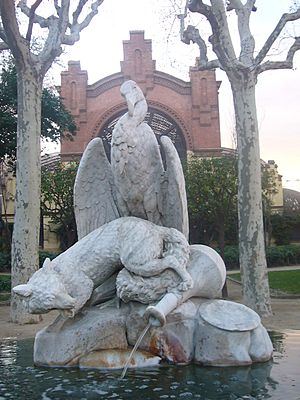The Fox and the Stork facts for kids

The Fox and the Stork, also known as The Fox and the Crane, is a famous story from Aesop's fables. These are ancient stories that often teach a lesson. This particular fable was first written down by a storyteller named Phaedrus. It is story number 426 in a list called the Perry Index.
Contents
The Story of the Fox and the Stork
The story begins with a clever fox inviting a stork to have dinner. The fox serves soup in a flat bowl. The fox can easily lap up the soup with its tongue. But the stork, with its long beak, cannot drink the soup at all.
Later, the stork invites the fox for a meal. The stork serves the food in a tall, narrow jar. The stork can easily reach the food with its long beak. However, the fox cannot get its snout into the jar to eat anything.
The main lesson of this fable is simple: if you play a trick on someone, you should expect them to play a trick on you too. It also teaches the golden rule: treat others the way you want to be treated.
The Fable in Art and Culture
This fable has been popular for hundreds of years. Artists have shown the story in many ways since the Middle Ages in Europe. One of the oldest pictures of the fable is on a church column in Aosta, Italy. It was made in the 12th century. This artwork shows both the fox's trick and the stork's revenge.
Over time, artists often chose to show only the stork getting its revenge. But since the 1800s, some artists have started showing both parts of the story again.
Famous Artworks and Places
The story was even part of the amazing Versailles labyrinth in France. This labyrinth was built for King Louis XIV to help teach his son. It had 39 statues that used water, and two of them showed the fox and the stork.
In a town called Barzy-sur-Marne, there are sculptures of the two animals. They are placed so you can imagine the meal yourself. The famous artist Pieter Bruegel the Elder also included the fable in his painting called Netherlandish Proverbs (1559). In this painting, the fox and the stork are shown sitting with their special dishes. This shows that tricksters often look out for themselves.
The story became even more famous when it appeared in La Fontaine's Fables (Book 1, story 18). After that, you could find the fox and the stork on many everyday items. These included buttons, plates, tiles, and even wallpaper! Many artists have painted scenes from this fable. Some of these artists include Frans Snyders and Jean-Baptiste Oudry. The fable also appears in a painting by Gustav Klimt called "The Fable" (1883).
In Barcelona, Spain, there is a fountain designed by Eduard Batiste Alentorn. It shows the frustrated fox kicking over the tall jar, with water pouring out.
Modern Appearances
In the 20th century, the story continued to be popular. It was featured on medals and in musical pieces. For example, the composer Louis Lacombe wrote music for it in 1875.
The fable has also appeared on postage stamps. Countries like Burundi, Dahomey (now Benin), Hungary, and Monaco have all issued stamps showing scenes from La Fontaine's fables, including the fox and the stork.
See also
 In Spanish: La zorra y la cigüeña para niños
In Spanish: La zorra y la cigüeña para niños


